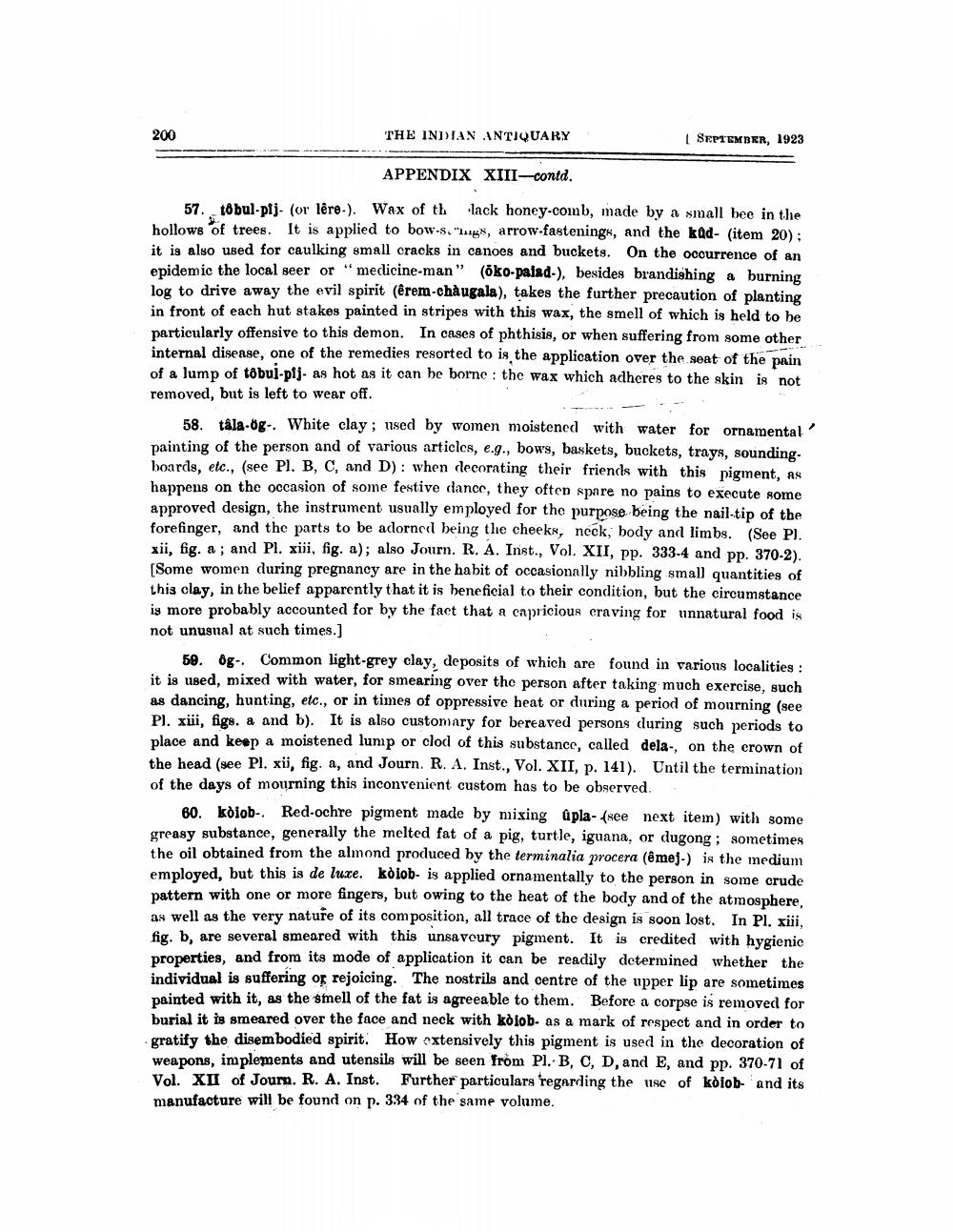________________
200
THE INDIAN ANTIQUARY
SEPTEMBER, 1923
APPENDIX XIII-contd.
57. tobul-plj (or lêre-). Wax of th lack honey-comb, made by a small bee in the hollows of trees. It is applied to bow-s. "gs, arrow-fastenings, and the kad- (item 20); it is also used for caulking small cracks in canoes and buckets. On the occurrence of an epidemic the local seer or "medicine-man" (öko-palad-), besides brandishing a burning log to drive away the evil spirit (êrem-chàugala), takes the further precaution of planting in front of each hut stakes painted in stripes with this wax, the smell of which is held to be particularly offensive to this demon. In cases of phthisis, or when suffering from some other internal disease, one of the remedies resorted to is the application over the seat of the pain of a lump of tôbui-plj. as hot as it can be borne: the wax which adheres to the skin is not removed, but is left to wear off.
58. tala-ög. White clay; used by women moistened with water for ornamental' painting of the person and of various articles, e.g., bows, baskets, buckets, trays, soundingboards, etc., (see Pl. B, C, and D): when decorating their friends with this pigment, as happens on the occasion of some festive dance, they often spare no pains to execute some approved design, the instrument usually employed for the purpose being the nail-tip of the forefinger, and the parts to be adorned being the cheeks, neck, body and limbs. (See Pl. xii, fig. a; and Pl. xiii, fig. a); also Journ. R. A. Inst., Vol. XII, pp. 333-4 and pp. 370-2). [Some women during pregnancy are in the habit of occasionally nibbling small quantities of this clay, in the belief apparently that it is beneficial to their condition, but the circumstance is more probably accounted for by the fact that a capricious craving for unnatural food is not unusual at such times.]
59. g. Common light-grey clay, deposits of which are found in various localities: it is used, mixed with water, for smearing over the person after taking much exercise, such as dancing, hunting, etc., or in times of oppressive heat or during a period of mourning (see Pl. xiii, figs. a and b). It is also customary for bereaved persons during such periods to place and keep a moistened lump or clod of this substance, called dela-, on the crown of the head (see Pl. xii, fig. a, and Journ. R. A. Inst., Vol. XII, p. 141). Until the termination of the days of mourning this inconvenient custom has to be observed.
60. kòiob-. Red-ochre pigment made by mixing upla- (see next item) with some greasy substance, generally the melted fat of a pig, turtle, iguana, or dugong; sometimes the oil obtained from the almond produced by the terminalia procera (êmej-) is the medium employed, but this is de luxe. kòlob- is applied ornamentally to the person in some crude pattern with one or more fingers, but owing to the heat of the body and of the atmosphere, as well as the very nature of its composition, all trace of the design is soon lost. In Pl. xiii, fig. b, are several smeared with this unsavoury pigment. It is credited with hygienic properties, and from its mode of application it can be readily determined whether the individual is suffering or rejoicing. The nostrils and centre of the upper lip are sometimes painted with it, as the smell of the fat is agreeable to them. Before a corpse is removed for burial it is smeared over the face and neck with kòiob- as a mark of respect and in order to gratify the disembodied spirit. How extensively this pigment is used in the decoration of weapons, implements and utensils will be seen from Pl. B, C, D, and E, and pp. 370-71 of Vol. XII of Journ. R. A. Inst. Further particulars regarding the use of kòiob- and its manufacture will be found on p. 334 of the same volume.




